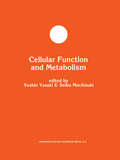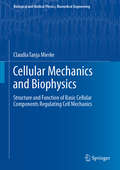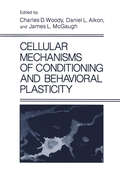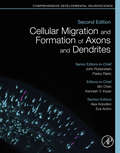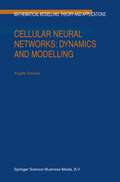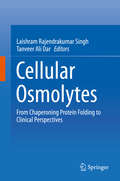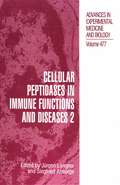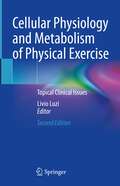- Table View
- List View
Cellular Function and Metabolism (Developments in Molecular and Cellular Biochemistry #9)
by Yoshio Yazaki Seibu MochizukiA variety of metabolic processes are known to be intimately involved in the maintenance of cellular structure and function. It has also become clear that metabolic events involved in the synthesis and hydrolysis of ATP as well as for the synthesis of proteins and phospholipids are essential for cellular health. The regulation of cell function is generally achieved through participation of a wide variety of hormones and different signal transduction mechanisms for the activation/deactivation of some specific metabolic processes. In this regard cyclic AMP and calcium seem to play a crucial role. Various hormones are also known to affect the genetic machinery of all the cell; however, the exact signals for genetic control of cellular function are not well defined. In particular, the sequence of events concerned with remodelling of different types of cells under various pathological situations is poorly understood. In this book we have therefore dealt with some of these issues from biochemical, molecular biological, physiological, and pharmacological viewpoints. Special emphasis has been laid on understanding heart function and metabolism in health and disease in general, and cardiac hypertrophy, heart failure, and ischemic heart disease in particular. It is hoped that this multidisciplinary information will be of value to basic scientists and clinical investigators.
Cellular Imaging Techniques for Neuroscience and Beyond
by Floris G. WouterloodThe imaging of small cellular components requires powerful instruments, and an entire family of equipment and techniques based on the confocal principle has been developed over the past 30 years. Such methods are commonly used by neuroscience researchers, but the majority of these users do not have a microscopy or a cell biology backgrounds and do can encounter difficulties in obtaining and interpreting results. This volume brings experts in high-resolution optical microscopy applications in neuroscience and cell biology together to document the state of the art. Outlining what is currently possible, the volume also discusses promising developments for the future and aids readers in selecting the most scientifically meaningful approach to solve their questions. Each chapter discusses instrumentation and technology in relationship to application in research. All of the common and cutting edge trends are covered - fluorescence / laser electron / nonlinear microscopy, infrared fluorescence, multiphoton imaging, tomography, FRAP, live imaging, STED, PALM/STORM, etc. Single and multiphoton confocal microscopy, and 4-pi confocal microscopy Obtaining nanoresolution via photoactivation localization microscopy (PALM) Several procedures that correlate observations in optical fluorescence microscopy and electron microscopy Study of morphology and function via high-resolution fluorescence procedures Additional high-resolution microscopic techniques
Cellular Injury in Liver Diseases (Cell Death in Biology and Diseases)
by Wen-Xing Ding Xiao-Ming YinThis volume has gathered together some of the world’s experts on cell death in liver diseases, covering topics on a variety of types of liver injury. Specifically, the chapters of this volume describe drug and virus-mediated hepatocyte injury, alcohol, lipid and bile acid-induced hepatocyte injury in addition to ischemia-reperfusion-mediated liver injury. The authors link these different types of liver injury to the commonly associated liver inflammation, fibrosis and tumorigenesis. Other topics explored include the various forms of cell death and cell survival pathways that have been identified in the liver, such as apoptosis, necroptosis, pryoptosis and autophagy. This book, along with its companion volume, Molecules, Systems and Signaling in Hepatic Cell Death, provides a thorough and comprehensive discussion on the topic of cell death and liver disease. Cellular Injury in Liver Diseases is an essential addition to the Cell Death in Biology and Diseases series and will appeal to scientists, clinicians and those doing research for drug discovery.
Cellular Interactions in Cardiac Pathophysiology (Developments in Molecular and Cellular Biochemistry #14)
by Ján Slezák Attila ZiegelhöfferDespite the considerable success in treating diseases of the heart and blood vessels, they still remain the major cause of mortality throughout the world. One of the reasons underlying this problem is our lack of understanding of the molecular and cellular aspects of the processes involved. These problems are fully discussed in Cellular Interactions in Cardiac Pathophysiology, which draws together 25 contributions from leading investigators from all parts of the world. The contributions are grouped under three headings: Extracellular matrix and cardiocyte interaction; Myocytic adaptations and myocardial injury; and Signal transduction.
Cellular Lipid Metabolism
by Christian EhnholmFor years lipids have fascinated cell biologists and biochemists due to their profound effects on cell function. "Cellular Lipid Metabolism" highlights new concepts and recent findings, but also reviews important discoveries made in the past. Outstanding international experts contribute 13 chapters on the genetics, molecular and cell biology of lipids. Presenting analyses at the molecular level they reveal the principles by which cellular lipid metabolism functions. Further, numerous intriguing observations that cannot yet be explained are identified, stimulating the readers to future studies. This book provides an invaluable source of information for biomedical researchers in energy metabolism, vascular biology, endocrinology and lipidology.
Cellular Mechanics and Biophysics: Structure and Function of Basic Cellular Components Regulating Cell Mechanics (Biological and Medical Physics, Biomedical Engineering)
by Claudia Tanja MierkeThis book focuses on the mechanical properties of cells, discussing the basic concepts and processes in the fields of immunology, biology, and biochemistry. It introduces and explains state-of-the-art biophysical methods and examines the role of mechanical properties in the cell/protein interaction with the connective tissue microenvironment. The book presents a unique perspective on cellular mechanics and biophysics by combining the mechanical, biological, physical, biochemical, medical, and immunological views, highlighting the importance of the mechanical properties of cells and biophysical measurement methods. The book guides readers through the complex and growing field of cellular mechanics and biophysics, connecting and discussing research findings from different fields such as biology, cell biology, immunology, physics, and medicine. Featuring suggestions for further reading throughout and addressing a wide selection of biophysical topics, this book is an indispensable guide for graduate and advanced undergraduate students in the fields of cellular mechanics and biophysics.
Cellular Mechanisms in Airways Inflammation (Progress in Inflammation Research)
by Clive P. Page, Katharine H. Banner and Domenico SpinaAirways inflammation is a complex biological phenomenon resulting from the recruitment and activation of numerous cell types. Airways inflammation contributes to the pathophysiology of airways disease. An understanding of the mechanisms that regulate inflammatory cell function is essential for the development of novel anti-inflammatory drugs for the treatment of common respiratory diseases such as asthma and COPD. This book provides a collection of valuable reviews on the major inflammatory cells involved in airways disease and examines the pharmacology of current anti-inflammatory drugs used in the treatment of airways disease. Moreover, an insight into the development of emerging drug therapies is also highlighted. This book is a must for the library of any researcher or clinician interested in the pathophysiology of airways disease.
Cellular Mechanisms of Conditioning and Behavioral Plasticity
by D. L. Alkon J. L. McGaugh C. D. WoodyI would like first to thank Charles Woody and his organizing committee for arranging the symposium on the "Cellular Mechanisms of Conditioning and Behavioral Plasticity," which was also a satellite meeting of the International Union of Physiological Sciences 30th International Congress. The proceedings of this symposium are represented by the chapters that follow. During the 1970s, Dr. Woody and co-workers were able to carry out a remarkable series of microelectrode studies, both intracellular and extracellular, of cortical nerve cells during conditioning of the eye-blink response to sound in the intact waking cat. He demonstrated enduring changes in excitability and membrane resistance in pericruciate cortical cells during associative conditioning of the eye blink, changes that are facilitated by ACh and cGMP and reinforced by stimulation of the hypothalamus (the latter con firming the original studies of Voronin). These findings have been of considerable im portance in our attempt to understand the conditioning process at the cellular level.
Cellular Mechanisms of Sensory Processing: The Somatosensory System (Nato ASI Subseries H: #79)
by Laszlo UrbanThe research field of somatosensory processing in mammals has experienced revolutionary changes in recent years. Accumulation of basic and clinical data has greatly accelerated, and new phenomena have emerged. With the aid of new, refined methods, molecular and cellular changes have been described, underlying the signal transduction-transmission between the internal/external environment and the central nervous system have been described. The discovery of the interaction between the nervous and the immune system has, for example changed our view on the development of inflammatory diseases, while the cloning of genes encoding different trophic factors has boosted studies revealing profound changes in the regeneration of neurons, and induction of changes in phenotype. The study of the pre-and postsynaptic modulation of transmitter release, and the examination of the combined effects of amino acid and peptide transmitters has become recently possible by using cultured cell lines and in vitro techniques. Although it is in embryonic state, computational properties of single DRG cells under normal and pathological conditions are being investigated. Results soon or later will have a great impact on pain research and consequently ultimately in clinical pain management. This brief introduction indicates how our knowledge of the somatosensory system has increased dramatically recently. However, many investigators cultivate only a very specific field in the growing area of somatosensory research and find it difficult to integrate a more universal knowledge of their work.
Cellular Metabolism of the Arterial Wall and Central Nervous System: Selected Aspects (Sitzungsberichte der Heidelberger Akademie der Wissenschaften #1993/94 / 1993/1)
by Gotthard Schettler, Heiner Greten and Andreas J. R. HabenichtInternational experts review the molecular biology of ion channels, diseases of the central nervous system including Alzheimer's disease, the molecular biology of atherogenesis, plasma lipproteins, lipid transport, long chain fatty acid transport and metabolism, and lipoprotein receptors. Future directions and perspectives and common features in these important areas are discussed.
Cellular Migration and Formation of Axons and Dendrites: Comprehensive Developmental Neuroscience
by John Rubenstein Pasko RakicCellular Migration and Formation of Neuronal Connections, Second Edition, the latest release in the Comprehensive Developmental Neuroscience series, presents the latest information on the genetic, molecular and cellular mechanisms of neural development. This book provides a much-needed update that underscores the latest research in this rapidly evolving field, with new section editors discussing the technological advances that are enabling the pursuit of new research on brain development. This volume focuses on the formation of axons and dendrites and cellular migration.Features leading experts in various subfields as section editors and article authorsPresents articles that have been peer reviewed to ensure accuracy, thoroughness and scholarshipIncludes coverage of mechanisms which regulate the formation of axons and dendrites and cellular migrationCovers neural activity, from cell-intrinsic maturation, to early correlated patterns of activity
Cellular, Molecular, and Clinical Aspects of Allergic Disorders (Comprehensive Immunology #6)
by Sudhir GuptaImpressive progress has been made in the general field of immunology which has made possible new understanding and pragmatic approaches to the patient with allergic disease. Indeed, one working in the field of immunology senses a major revolution of immunobiologic thinking, much of which has relevance to the clinical practice of allergy. To the practicing allergist, pediatrician, or internist who must deal with allergic patients, the surging new information may seem confusing and bewildering. As part of our comprehensive series on modern immunobiology which aims to digest this progress, we believe it is appropriate to devote an entire volume to the fundamental principles, new knowledge, and clinical lore on which the modern practice of allergy must be based. In the present volume we strive to bring together relevant contributions from leaders in the field of immunobiology with those whose work stands at the forefront of clinical practice. The advancing understanding has in numerous instances reached the point of clinical application, and we have tried to encompass in this volume the entire scope of modern allergy.
Cellular Neural Networks: Dynamics and Modelling (Mathematical Modelling: Theory and Applications #16)
by A. SlavovaConventional digital computation methods have run into a se rious speed bottleneck due to their serial nature. To overcome this problem, a new computation model, called Neural Networks, has been proposed, which is based on some aspects of neurobiology and adapted to integrated circuits. The increased availability of com puting power has not only made many new applications possible but has also created the desire to perform cognitive tasks which are easily carried out by the human brain. It become obvious that new types of algorithms and/or circuits were necessary to cope with such tasks. Inspiration has been sought from the functioning of the hu man brain, which led to the artificial neural network approach. One way of looking at neural networks is to consider them to be arrays of nonlinear dynamical systems that interact with each other. This book deals with one class of locally coupled neural net works, called Cellular Neural Networks (CNNs). CNNs were intro duced in 1988 by L. O. Chua and L. Yang [27,28] as a novel class of information processing systems, which posseses some of the key fea tures of neural networks (NNs) and which has important potential applications in such areas as image processing and pattern reco gnition. Unfortunately, the highly interdisciplinary nature of the research in CNNs makes it very difficult for a newcomer to enter this important and fasciriating area of modern science.
Cellular Oscillatory Mechanisms: (pdf) (Advances in Experimental Medicine and Biology #641)
by Miguel Maroto Nick MonkCellular Osmolytes: From Chaperoning Protein Folding to Clinical Perspectives
by Laishram Rajendrakumar Singh Tanveer Ali DarThis book provides essential information on improving protein folding/stability, which is a result of the balance between the intra-molecular interactions of protein functional groups and their interactions with the solvent environment. The protein folding solvent environment mainly consists of salts, small molecule compounds, metabolites, molecular chaperones and other chemical species. Therefore, subtle change in the composition of the environment will alter the protein folding process. The importance of the solvent environment in protein folding is precisely due to the fact that various disease-causing proteopathies can be reversed by manipulating the solvent environment of the malfolded proteins. Hostile environmental stresses represent one of the basic causes of such challenges in protein folding or misfolding. Since cells commonly encounter extreme environmental fluctuations, it is crucial that they equip themselves with strategies to circumvent the hostile environmental conditions. Nature has developed many strategies to ensure that the complex and challenging protein folding reaction occurs with adequate efficiency and fidelity for the success of the organism. Among the strategies employed in a wide range of species and cell types is the elaboration of small organic molecules called osmolytes. Additionally, recent advances have also revealed that certain specific osmolytes might be key biomarkers of cancer, infectious diseases and vaccine flocculation. In fact, a large pool of data has been generated regarding their potential for the therapeutic intervention of neurodegenerative diseases and other metabolic disorders caused by protein aggregation or proteostasis failure. Reflecting the multiple applications of these small molecules in the health and other industries, this book combines contributions by respected leaders in the field and will help to inspire college students, basic researchers, and clinicians to translate these biological roles of osmolytes into clinical practice. It will also shed light on some important future prospects of osmolytes like their role as drug excipients and provide a deeper understanding of their mechanism of action in the prevention of neuro-degenerative diseases.
Cellular Osmolytes: From Chaperoning Protein Folding to Clinical Perspectives
by Laishram Rajendrakumar Singh Tanveer Ali Dar Kritika KumariThe second edition of this book presents the role of osmolytes in human health and diseases. Some of the chapters deal about the possibility of the use of osmolytes as diagnostic biomarkers and potential drug design for neurodegenerative and other human diseases. Other chapters also include reviews on the role of osmolytes in cancer, metastasis, infectious diseases, metabolic disorders, immunological disorders, and tissue regeneration. Importantly, the book also contain recent updates on the role of naturally occurring osmolytes in protein folding pathway, protein stability, and their underlying mechanisms. The book also covers the aspects that osmolytes could promote conformational alterations of transcription factors that favor metastatic behavior. Potential of the osmolytes in the various process of vaccine development, including enhancing the efficacy, production, and purification steps are also succintly described. Towards the end, the book also elucidates the use of specific molecules for the prevention of toxic gain of functions and restoration of function to disease-causing mutant protein. This book is an invaluable asset for the researchers especially working in osmolyte biology and scientists involved in basic and clinical research particularly neurodegeneration, diabetes, cancer, and metabolic disorders.
Cellular Pathology of Glandular Lesions and Uncommon Neoplasms of the Cervix
by W. Glenn McCluggage John Tidy John H.F. SmithThis book provides a comprehensive account of the cellular pathology of glandular lesions and uncommon neoplasms of the cervix and places these in a contemporary clinical context. The book features comprehensive, detailed descriptions and a consistent approach to each tumor or tumor-like condition with clear color illustrations. Cytological/histological correlation is emphasised and diagnostic pitfalls are highlighted. Cellular Pathology of Glandular Lesions and Uncommon Neoplasms of the Cervix is aimed at both trainee and consultant pathologists.
Cellular Patterns
by Antonio Siber Primoz ZiherlThe mechanics underlying the form and structure of biological tissues is being increasingly investigated and appreciated, with new results appearing at a fast pace. Cellular Patterns covers the salient elements of this thriving field of research in a textbook style, including both historic landmark results and recent achievements. By building on concepts such as packing, confinement, surface tension, and elastic instabilities, the book explains the structure and the shape of sheet-like and bulk tissues by adapting the mechanics of continuous media to living matter. It reviews experimental results and empirical laws, and wherever possible, it discusses more than a single theoretical interpretation of a given phenomenon. The in-depth treatment of technical details, the many boxes summarizing essential physical and biological ideas, and an extensive set of problems make this book suitable as a complementary textbook for a graduate course in biophysics and as a standalone reference for students and researchers in biophysics, bioengineering, and mathematical biology interested in the mechanics of tissue. Features: Provides an overview of patterns and shapes seen in animal tissues in addition to an interpretation of these structures in terms of physical forces and processes Contains detailed analysis and a critical comparison of mechanical models of cells, tissues, and morphogenetic movements Presents a visually rich style which is accessible to physicists and biologists alike
Cellular Patterns
by Antonio Siber Primoz ZiherlThe mechanics underlying the form and structure of biological tissues is being increasingly investigated and appreciated, with new results appearing at a fast pace. Cellular Patterns covers the salient elements of this thriving field of research in a textbook style, including both historic landmark results and recent achievements. By building on concepts such as packing, confinement, surface tension, and elastic instabilities, the book explains the structure and the shape of sheet-like and bulk tissues by adapting the mechanics of continuous media to living matter. It reviews experimental results and empirical laws, and wherever possible, it discusses more than a single theoretical interpretation of a given phenomenon. The in-depth treatment of technical details, the many boxes summarizing essential physical and biological ideas, and an extensive set of problems make this book suitable as a complementary textbook for a graduate course in biophysics and as a standalone reference for students and researchers in biophysics, bioengineering, and mathematical biology interested in the mechanics of tissue. Features: Provides an overview of patterns and shapes seen in animal tissues in addition to an interpretation of these structures in terms of physical forces and processes Contains detailed analysis and a critical comparison of mechanical models of cells, tissues, and morphogenetic movements Presents a visually rich style which is accessible to physicists and biologists alike
Cellular Peptidases in Immune Functions and Diseases (Advances in Experimental Medicine and Biology #421)
by Siegfried Ansorge Jurgen LangnerProceedings of an international conference held in Magdeburg, Germany, November 3-5, 1996
Cellular Peptidases in Immune Functions and Diseases 2: (pdf) (Advances in Experimental Medicine and Biology #477)
by Jürgen Langner Siegfried AnsorgeCellular Physiology and Metabolism of Physical Exercise
by Livio LuziThe book covers areas of cellular physiology and metabolism that are of interest to scientists involved in research in diabetes and metabolic diseases. Some chapters of the book are specifically research-oriented, as all the authors are actively practicing either bench or clinical research in the area. Nonetheless, since the work is fully comprehensive of the discipline, it is also suitable for university classes of graduate and undergraduate students. In particular, the book discusses classical aspects of cellular physiology and the metabolism of physical exercise, as well as novel topics like exercise in transplantation and exercise in beta-cell failure, which mark the frontiers of research in sport-related sciences and research. Exercise physiologists, biologists and physicians are the specific professional and academic targets of this work. The team of authors together with the editor are world-renowned experts in the field of physiology and metabolism applied to sport sciences.
Cellular Physiology and Metabolism of Physical Exercise: Topical Clinical Issues
by Livio LuziThis new edition discusses classical aspects of cellular physiology and the metabolism of physical exercise, as well as novel topics like exercise in transplantation and exercise in beta-cell failure, which mark the frontiers of research in sport-related sciences and research. The team of authors together with the editor are world-renowned experts in the field of physiology and metabolism applied to sport sciences. In order to make the book answering also to current pandemic clinical issue, this second edition includes new chapters, specifically dealing with COVID-related issues.Exercise physiologists, biologists and physicians will benefit from this book. However, the comprehensive nature of the content makes this publication suitable also for university classes of graduate and undergraduate student.
Cellular Physiology and Neurophysiology: Mosby Physiology Monograph Series (PDF)
by Mordecai P. Blaustein Joseph P. Y. Kao Donald R. MattesonGain a quick and easy understanding of this complex subject with the 2nd edition of Cellular Physiology and Neurophysiology by doctors Mordecai P. Blaustein, Joseph PY Kao, and Donald R. Matteson. The expanded and thoroughly updated content in this Mosby Physiology Monograph Series title bridges the gap between basic biochemistry, molecular and cell biology, neuroscience, and organ and systems physiology, providing the rich, clinically oriented coverage you need to master the latest concepts in neuroscience. See how cells function in health and disease with extensive discussion of cell membranes, action potentials, membrane proteins/transporters, osmosis, and more. Intuitive and user-friendly, this title is a highly effective way to learn cellular physiology and neurophysiology, and it's available in print and online at www. studentconsult. com. Focus on the clinical implications of the material with frequent examples from systems physiology, pharmacology, and pathophysiology. Gain a solid grasp of transport processes-which are integral to all physiological processes, yet are neglected in many other cell biology texts. Understand therapeutic interventions and get an updated grasp of the field with information on recently discovered molecular mechanisms. Conveniently explore mathematical derivations with special boxes throughout the text. Test your knowledge of the material with an appendix of multiple-choice review questions, complete with correct answers Understand the latest concepts in neurophysiology with a completely new section on Synaptic Physiology. Learn all of the newest cellular physiology knowledge with sweeping updates throughout. Reference key abbreviations, symbols, and numerical constants at a glance with new appendices. Study with the book online at www. studentconsult. com. Gain a quick and easy understanding of the physiology of cells and nerve cells
Cellular Physiology and Neurophysiology E-Book: Mosby Physiology Monograph Series (Mosby's Physiology Monograph)
by Mordecai P. Blaustein Joseph P. Kao Donald R. MattesonGain a quick and easy understanding of this complex subject with the 2nd edition of Cellular Physiology and Neurophysiology by doctors Mordecai P. Blaustein, Joseph PY Kao, and Donald R. Matteson. The expanded and thoroughly updated content in this Mosby Physiology Monograph Series title bridges the gap between basic biochemistry, molecular and cell biology, neuroscience, and organ and systems physiology, providing the rich, clinically oriented coverage you need to master the latest concepts in neuroscience. See how cells function in health and disease with extensive discussion of cell membranes, action potentials, membrane proteins/transporters, osmosis, and more. Intuitive and user-friendly, this title is a highly effective way to learn cellular physiology and neurophysiology. Focus on the clinical implications of the material with frequent examples from systems physiology, pharmacology, and pathophysiology. Gain a solid grasp of transport processes—which are integral to all physiological processes, yet are neglected in many other cell biology texts. Understand therapeutic interventions and get an updated grasp of the field with information on recently discovered molecular mechanisms. Conveniently explore mathematical derivations with special boxes throughout the text. Test your knowledge of the material with an appendix of multiple-choice review questions, complete with correct answersUnderstand the latest concepts in neurophysiology with a completely new section on Synaptic Physiology. Learn all of the newest cellular physiology knowledge with sweeping updates throughout. Reference key abbreviations, symbols, and numerical constants at a glance with new appendices.
